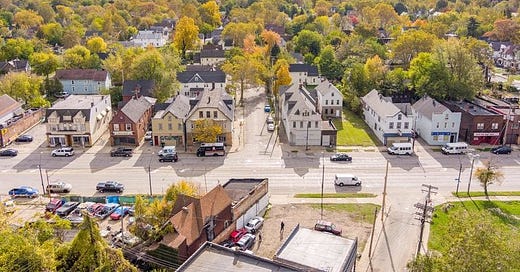Untying The Urban Garlic Knot
Older city neighborhoods often have good housing stock, and efforts to stabilize some of them are working. But can these efforts scale to the point where they'd make a big difference?
Thanks for reading The Future Of Where. I have a great time writing it and interacting with readers. But to keep going, we need two things: more readers and more money. Please consider becoming a paid subscriber today. (You can also become a free subscriber.) Thanks!
A few years ago I went to a conference in Cleveland, where we toured the St. Clair-Superior neighborhood, located on the city’s East Side. What we saw was a struggling neighborhood that appeared to be on the way back.
St. Clair-Superior was originally a neighborhood of Lithuanian and Slovenian factory workers, built rapidly in the early 20th Century as the factories in Cleveland boomed. It had become predominantly African-American over the years – not because a lot of Blacks moved in but because a lot of whites moved out. The population of the neighborhood – 1.4 square miles in size – dropped from 20,000 people in 1970 to only 5,000 in recent years.
Cleveland’s St. Clair-Superior neighborhood.
But there were signs of revitalization – some might say gentrification – and we wound up the day at the then-brand-new Goldhorn Brewery (named for a Slovenian folk tale), where we settled in for a discussion of the neighborhood with the St. Claire-Superior Development Corporation. And that’s when reality set in.
One of the development corporation’s priorities at that time was renovating a small number of older but still serviceable houses and selling them to local residents, often for less than the cost of renovation. A worthy goal, I thought, but why would that be a priority, especially if you couldn’t scale it?
The answer was both surprising and simple: The appraisers needed comps.
For a guy who has spent most of his career in California and Texas, this was a shock. But for the people in St. Clair-Superior, it was a reality. Yes, houses were cheap, though renovating them was expensive – often more than the house was worth. If you could put a value on it. Which appraisers couldn’t, because there had been almost no market transactions for these houses in a generation or two. Which means nobody could get a mortgage even if they could otherwise qualify for one.
And that’s the kind of problem you see in the outlying neighborhood of “Garlic Knot Cities”.
You can expand our reach by sharing this post with others so we get even more readers!
On Monday, I wrote about “Garlic Knot Cities” – legacy cities like Cleveland that have lost population but are nevertheless dense and satisfying in the center, though outlying neighborhoods may still have trouble.
I got an interesting response to this piece from Dion Thompson-Davoli from the National Association of Development Organizations (commonly known as NADO), who challenged me by saying that, in fact, a lot is going on in outlying neighborhoods in these Garlic Knot cities. After we went back and forth, we both agreed that many of these neighborhoods have good old housing stock that represents an opportunity. Demolition, which has so often been pursued in these cities as the neighborhoods decline, should not be the only option.
But as the St. Clair-Superior example shows, demand and market activity remain a problem. So much of supposed solution to declining neighborhoods over the past 50 years has been to build brand-new affordable housing even though the population is going down and older houses are sitting vacant. As I mentioned the other day, a Baltimore colleague once remarked to me that “you can’t build your way out of a housing surplus”. Which is what Baltimore has tried to do – according to the Census, the city has 50,000 more housing units today than it did in 1950, even though it has only a little over half the population. (This stands in contrast to Detroit, which has lost not only two-thirds of its population but also half of its housing units since 1950.)
How To Stabilize Neighborhoods
All over the country, we are seeing community development organizations doing great work to stabilize these neighborhoods in a variety of ways.
One of the most important tools in this stabilization effort is the use of land banks and community land trusts. For example, over the past decade, the Detroit Land Bank Authority has renovated and sold 12,000 formerly vacant, blighted houses, which it claims has helped stabilize 5,000 city blocks in Detroit. (The Authority’s Rehabbed and Ready program, as in Cleveland, sells houses at their true market value in order to create comps; it doesn’t hurt that they partner with Dan Gilbert’s Rocket Community Fund, which obviously has ties to the mortgage industry.)
Hamilton Hill in the former GE town of Schenectady, which has struggled to come back.
Meanwhile, in St. Louis, the Land Reutilization Authority has moved past its traditional role of simply holding tax lots until they crumble. (St. Louis’s population has dropped from 850,000 to 300,000 since 1950.) Using funds from 2017’s Proposition NS (for Neighborhood Stabilization) bond initiative, the LRA invests up to $30,000 per single-family home to stabilize them as a means of making them rehab ready for buyers. LRA says 170 homes have been saved this way.
The Twin Problems of Scale and Demand
There are many other efforts in legacy cities around the country, often supported by either local bonds funds or philanthropy. But scale remains a problem. In Detroit,





